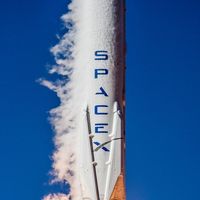SpaceX's Bold Leap into the Void: The Polaris Dawn Mission
August 28, 2024, 4:04 pm

Location: United States, Florida, Wedgefield
Employees: 11-50
Founded date: 2015
Total raised: $40M

Location: United States, District of Columbia, Washington
Employees: 5001-10000
Founded date: 2002
Total raised: $7.53B

Location: United States, Maryland, Greenbelt
Employees: 10001+
Founded date: 1958
Total raised: $25.7B
SpaceX is set to make history. The Polaris Dawn mission will mark the first-ever private spacewalk. This ambitious venture is not just a test of human courage; it’s a trial of cutting-edge technology. The stakes are high, and the risks are palpable. As the world watches, SpaceX prepares to push the boundaries of space exploration.
The Polaris Dawn mission is a bold step into the unknown. Scheduled for launch on Tuesday, it will see a crew of four venture into the vastness of space aboard a modified Crew Dragon spacecraft. Among them is billionaire Jared Isaacman, a retired military pilot, and two SpaceX engineers. They will embark on a journey that takes them 434 miles above Earth, where they will attempt a 20-minute spacewalk two days later.
This mission is not just about exploration; it’s about innovation. SpaceX is testing new equipment, including slim spacesuits and a cabin designed to operate without an airlock. This is uncharted territory. Until now, only government astronauts have dared to walk in the void, tethered to the International Space Station. Polaris Dawn will change that narrative.
The mission’s trajectory is equally ambitious. It will swing in an oval orbit, dipping as low as 190 kilometers and soaring as high as 1,400 kilometers. This altitude is significant. It’s the farthest humans have traveled since the Apollo program. The crew will encounter a harsher radiation environment, pushing the limits of both technology and human endurance.
SpaceX’s approach is audacious. The Crew Dragon’s cabin will be depressurized, exposing the interior to the vacuum of space. Only two crew members will venture outside, tethered by an oxygen line. The rest will rely on their spacesuits for life support. This is a high-wire act with no safety net.
Preparation for the spacewalk begins long before the crew steps outside. They will undergo a “pre-breathe” process, filling the cabin with pure oxygen to eliminate nitrogen. This step is crucial. Nitrogen bubbles in the bloodstream can lead to decompression sickness, a dangerous condition akin to “the bends” experienced by scuba divers. The crew will monitor their bodies closely, using ultrasound devices to detect any potential issues.
The mission is a testbed for future space exploration. SpaceX aims to gather data that could inform human missions to the Moon and Mars. The technology being tested could pave the way for sustainable human presence beyond Earth. It’s a stepping stone to the stars.
However, the mission is not without its challenges. SpaceX operates in a regulatory gray area. While NASA missions are subject to strict safety protocols, private missions like Polaris lack comprehensive oversight. This raises questions about the safety of the crew and the technology being tested. SpaceX has prepared for various contingencies, but the specifics remain undisclosed. The uncertainty looms large.
The Polaris crew is well aware of the risks. They are seasoned professionals, trained to handle unexpected situations. Yet, as a retired NASA astronaut noted, “there’s not a lot of room for error.” The margin for safety is razor-thin. Every decision counts.
The Polaris Dawn mission is a testament to human ingenuity and ambition. It embodies the spirit of exploration that has driven humanity to the stars. As the crew prepares for launch, they carry the hopes of a new era in space travel. They are not just astronauts; they are pioneers.
In the coming days, the world will hold its breath. The launch will be a spectacle, a moment where science fiction meets reality. As the Crew Dragon ascends into the sky, it will carry with it the dreams of countless individuals who look to the stars.
SpaceX is not just launching a spacecraft; it is launching a vision. A vision of a future where space is accessible to all. A future where private missions complement government efforts. The Polaris Dawn mission is a bold step toward that future.
As the countdown begins, excitement and anxiety intertwine. The crew knows the risks, yet they embrace the challenge. They are ready to push the envelope, to redefine what is possible. The void awaits, and they are prepared to dance with the stars.
In the end, the Polaris Dawn mission is more than a spacewalk. It is a leap into the unknown, a test of human spirit and technological prowess. As we watch this historic event unfold, we are reminded of our innate desire to explore, to discover, and to reach for the stars. The journey has just begun.
The Polaris Dawn mission is a bold step into the unknown. Scheduled for launch on Tuesday, it will see a crew of four venture into the vastness of space aboard a modified Crew Dragon spacecraft. Among them is billionaire Jared Isaacman, a retired military pilot, and two SpaceX engineers. They will embark on a journey that takes them 434 miles above Earth, where they will attempt a 20-minute spacewalk two days later.
This mission is not just about exploration; it’s about innovation. SpaceX is testing new equipment, including slim spacesuits and a cabin designed to operate without an airlock. This is uncharted territory. Until now, only government astronauts have dared to walk in the void, tethered to the International Space Station. Polaris Dawn will change that narrative.
The mission’s trajectory is equally ambitious. It will swing in an oval orbit, dipping as low as 190 kilometers and soaring as high as 1,400 kilometers. This altitude is significant. It’s the farthest humans have traveled since the Apollo program. The crew will encounter a harsher radiation environment, pushing the limits of both technology and human endurance.
SpaceX’s approach is audacious. The Crew Dragon’s cabin will be depressurized, exposing the interior to the vacuum of space. Only two crew members will venture outside, tethered by an oxygen line. The rest will rely on their spacesuits for life support. This is a high-wire act with no safety net.
Preparation for the spacewalk begins long before the crew steps outside. They will undergo a “pre-breathe” process, filling the cabin with pure oxygen to eliminate nitrogen. This step is crucial. Nitrogen bubbles in the bloodstream can lead to decompression sickness, a dangerous condition akin to “the bends” experienced by scuba divers. The crew will monitor their bodies closely, using ultrasound devices to detect any potential issues.
The mission is a testbed for future space exploration. SpaceX aims to gather data that could inform human missions to the Moon and Mars. The technology being tested could pave the way for sustainable human presence beyond Earth. It’s a stepping stone to the stars.
However, the mission is not without its challenges. SpaceX operates in a regulatory gray area. While NASA missions are subject to strict safety protocols, private missions like Polaris lack comprehensive oversight. This raises questions about the safety of the crew and the technology being tested. SpaceX has prepared for various contingencies, but the specifics remain undisclosed. The uncertainty looms large.
The Polaris crew is well aware of the risks. They are seasoned professionals, trained to handle unexpected situations. Yet, as a retired NASA astronaut noted, “there’s not a lot of room for error.” The margin for safety is razor-thin. Every decision counts.
The Polaris Dawn mission is a testament to human ingenuity and ambition. It embodies the spirit of exploration that has driven humanity to the stars. As the crew prepares for launch, they carry the hopes of a new era in space travel. They are not just astronauts; they are pioneers.
In the coming days, the world will hold its breath. The launch will be a spectacle, a moment where science fiction meets reality. As the Crew Dragon ascends into the sky, it will carry with it the dreams of countless individuals who look to the stars.
SpaceX is not just launching a spacecraft; it is launching a vision. A vision of a future where space is accessible to all. A future where private missions complement government efforts. The Polaris Dawn mission is a bold step toward that future.
As the countdown begins, excitement and anxiety intertwine. The crew knows the risks, yet they embrace the challenge. They are ready to push the envelope, to redefine what is possible. The void awaits, and they are prepared to dance with the stars.
In the end, the Polaris Dawn mission is more than a spacewalk. It is a leap into the unknown, a test of human spirit and technological prowess. As we watch this historic event unfold, we are reminded of our innate desire to explore, to discover, and to reach for the stars. The journey has just begun.